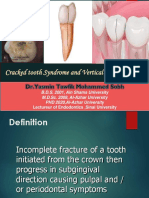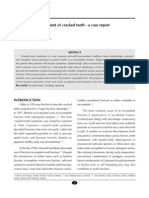Cracked Tooth
Cracked Tooth
Uploaded by
Melissa Von SchoberCopyright:
Available Formats
Cracked Tooth
Cracked Tooth
Uploaded by
Melissa Von SchoberCopyright
Available Formats
Share this document
Did you find this document useful?
Is this content inappropriate?
Copyright:
Available Formats
Cracked Tooth
Cracked Tooth
Uploaded by
Melissa Von SchoberCopyright:
Available Formats
Talking with Patients
Cracked Tooth
Lee W. Boushell, DMD, MS*
WHAT IS IT? pulp’s response to the presence of in ongoing fracture propagation
the bacteria in the fracture. Crack deeper into the dentin with result-
The term “cracked tooth” is gener-
propagation may also extend into ant increased sensitivity. Some
ally used to describe the develop-
the root system of a tooth. cracked teeth are only painful
ment of a fracture that follows the
when chewing harder foods or
long axis of a tooth. Shallow
On occasion, sideways forces on chewing with the teeth in certain
cracks (generally referred to as
the tooth cause the vertical fracture positions. Frequently, fractures
“craze lines”) are limited to the
to propagate in a horizontal extend horizontally, and a portion
outside layer (enamel) of teeth.
fashion (Figure 1) and may eventu- of the tooth (a complete fracture)
Excessive biting forces may lead to
ally result in loss of part of the is obviously lost.
progression of a surface fracture
tooth (e.g., a complete cusp frac-
through the enamel and into the
ture). Loss of tooth structure from Dentists will use careful visual
sensitive part of the tooth called
dental decay frequently increases examination to identify the loca-
dentin. Fractures may grow in
tooth susceptibility to fracture for- tion of suspected incomplete frac-
depth and width, which allows
mation. Teeth that have therapeutic tures. Early fractures may require
staining by food molecules and
removal of diseased nerve tissue the use of a small light that is
invasion by bacteria of the oral
(“root canal treatment”) are at placed on the cheek side and
cavity. Fractures that initially do
greater risk for fracture of the tongue side of the tooth. The light
not result in loss of part of the
crown and/or the root of the tooth. passing into the tooth will abruptly
tooth are considered incomplete.
stop at the fracture, which enables
Incomplete fractures that are HOW IS IT DIAGNOSED visual detection. Long-standing
moving vertically further into the AND TREATED? fractures frequently are stained and
dentin or “propagating” may cause Your dentist may identify enamel easily seen. Incomplete fractures
pain during chewing or when the craze lines during routine examina- are rarely detected by standard
teeth are pressed firmly together tions. These craze lines do not radiographic analysis. The presence
(Figure 1). This sensitivity may cause sensitivity and do not require of bacteria in these fractures may
cease when propagation stops and any treatment. In addition to craze result in the development of decay
then return if the fracture begins to lines, cracked teeth that are not along the fracture. This decay may
extend deeper into the tooth struc- sensitive are commonly seen by be visually detected by changes in
ture. If the fracture progresses into dental health-care providers. In the color and transparency of the
the nerve center (“the pulp”) of the most cases, the initial development tooth adjacent to the fracture
tooth, then sensitivity during of these cracked teeth resulted in and/or by use of dental radio-
chewing may increase to a con- an immediate pain that rapidly dis- graphs. Selective pressure applied
tinual pain that will continue until sipated, leaving no further sensitiv- to individual cusps of a suspicious
the nerve dies or is removed. The ity for a period of time. Ongoing tooth is used to identify if a frac-
primary reason for the pain is the chewing pressures frequently result ture is active, its relative location,
*Assistant Professor, Department of Operative Dentistry,
University of North Carolina at Chapel Hill School of Dentistry, Chapel Hill, NC, USA
© 2009, COPYRIGHT THE AUTHOR
J O U R N A L C O M P I L AT I O N © 2 0 0 9 , W I L E Y P E R I O D I C A L S , I N C .
68 DOI 10.1111/j.1708-8240.2008.00233.x VOLUME 21, NUMBER 1, 2009
TA L K I N G W I T H PAT I E N T S
procedure is the potential develop-
ment of a vertical fracture in the
root system. Fractures that extend
through the pulp and into the root
system of the tooth usually cannot
be reinforced, and the tooth
is extracted.
CONCLUSIONS
A “cracked tooth” has developed
a vertical fracture that has the
Figure 1. Teeth with incomplete vertical fractures (black potential to propagate over time.
arrows) and an incomplete horizontal fracture (white Increased fracture severity may
arrow) (courtesy of Dr. John Sturdevant, University of progressively lead to chewing
North Carolina–Chapel Hill).
sensitivity, tooth decay, loss of
part of a tooth, nerve (pulp)
and the region of the tooth that is involved the pulp of the tooth is problems, and, in extreme cases,
involved. Fractures that begin to reinforced with a restoration that tooth removal. Regular dental
extend onto the root surface may covers the biting surface, such as care and good communication
create an isolated gum defect an onlay or crown. The goals of between you and your dentist
that can be detected during a this procedure are to rigidly will allow early detection
dental evaluation. encircle the tooth structure that of fractures. Early intervention
contains the fracture, distribute increases the chances of successful
Your dentist has multiple means biting pressures over the whole reinforcement procedures. Frac-
of restoring lost portions of your tooth, and limit the potential for tures that involve the pulp will
tooth. These include fillings placed further propagation. require its removal. The nature of
directly in/on your tooth to create the tooth sensitivity and diagnos-
normal shape and function. A Fracture invasion into the pulp tic findings will help your dentist
more severe complete fracture necessitates its removal followed prescribe appropriate steps indi-
requires the use of an onlay or by reinforcement of the cracked cated to give your cracked tooth
crown. A sensitive tooth with an tooth as described above. An asso- the greatest chance of normal use
incomplete fracture that has not ciated risk of the pulp removal for a lifetime.
VOLUME 21, NUMBER 1, 2009 69
You might also like
- Pacquet2022 - Therapeutic Strategy For Cracked TeethDocument17 pagesPacquet2022 - Therapeutic Strategy For Cracked TeethJosé Ramón CuetoNo ratings yet
- Reading and Writing 3 Q: Skills For Success Unit 5 Student Book Answer KeyDocument2 pagesReading and Writing 3 Q: Skills For Success Unit 5 Student Book Answer KeyQuỳnh LươngNo ratings yet
- Ellinger 1971Document7 pagesEllinger 1971Mohammed TarekNo ratings yet
- Niner Catalog 2013Document28 pagesNiner Catalog 2013Switchback BikesNo ratings yet
- Cracked Tooth Syndrome: A Review of The LiteratureDocument8 pagesCracked Tooth Syndrome: A Review of The Literaturetexew44804No ratings yet
- Cracked Tooth Syndrome and Vertical Root Fracture 2 1 1Document85 pagesCracked Tooth Syndrome and Vertical Root Fracture 2 1 1Mohamed Ali AbdelhamedNo ratings yet
- Cracked Tooth SyndromDocument19 pagesCracked Tooth SyndromNUHA ELKADIKINo ratings yet
- Cracked Tooth Syndrome-Decoding The EnigmaDocument3 pagesCracked Tooth Syndrome-Decoding The EnigmaVerghese George MNo ratings yet
- Bhañjanaka: Clinical FeaturesDocument5 pagesBhañjanaka: Clinical FeaturesUdaya ShankarNo ratings yet
- XXXXX 22222Document5 pagesXXXXX 22222Hans GuilasNo ratings yet
- Avulsionofpermanentteeth Theorytopracticetrope2011 PDFDocument14 pagesAvulsionofpermanentteeth Theorytopracticetrope2011 PDFFatin InsaaniNo ratings yet
- Opd ReviewerDocument8 pagesOpd ReviewerPrince Alfonso LeddaNo ratings yet
- Ajman University of Science and TechnoloddgyDocument10 pagesAjman University of Science and TechnoloddgyZainab Al-ObaidiNo ratings yet
- Orth Update 2023 16 85-90Document6 pagesOrth Update 2023 16 85-90jlkdsjfljsdlfNo ratings yet
- Vertical Root Fracture - A Dilemma RevisitedDocument6 pagesVertical Root Fracture - A Dilemma RevisitedLuis KabreraNo ratings yet
- 22-Trauma 5Document13 pages22-Trauma 5Ahmed aljumailiNo ratings yet
- Cracked Tooth DiagDocument11 pagesCracked Tooth DiagskivinoNo ratings yet
- Vertical Root Fracture !Document42 pagesVertical Root Fracture !Dr Dithy kkNo ratings yet
- 5th Year Lec No13 ETIOLOGY OF MALOCCLUSIONDocument15 pages5th Year Lec No13 ETIOLOGY OF MALOCCLUSIONf9nw8989j2No ratings yet
- Dentoalveolar Injuries and Wiring TechniquesDocument60 pagesDentoalveolar Injuries and Wiring Techniquessamys2ndemailNo ratings yet
- Longitudinal Tooth FracturesDocument31 pagesLongitudinal Tooth FracturesĐức Anh Lê CôngNo ratings yet
- Cracked Tooth SyndromDocument9 pagesCracked Tooth Syndromzeina32No ratings yet
- Management of Cracked TeethDocument6 pagesManagement of Cracked Teethsaifuddin suhri100% (2)
- Jdhodt 01 00025Document6 pagesJdhodt 01 00025dithaNo ratings yet
- Dental Traumatology-Medicolegal Aspects (Indian Perspective)Document6 pagesDental Traumatology-Medicolegal Aspects (Indian Perspective)akish4uNo ratings yet
- Dafpus No. 8Document7 pagesDafpus No. 8febrina zwestianaNo ratings yet
- Cracked Tooth Syndrome FDIDocument2 pagesCracked Tooth Syndrome FDIfdnbqkm965No ratings yet
- Canine Treatment Options FlyerDocument2 pagesCanine Treatment Options FlyerAlen ZahorjevićNo ratings yet
- Kegawatdaruratan EndoDocument38 pagesKegawatdaruratan EndoAnisya AbabeliaNo ratings yet
- Cracked Tooth Syndrome Overview of LiteratureDocument5 pagesCracked Tooth Syndrome Overview of LiteratureOmar Al FeqiNo ratings yet
- Dental Emergencies SummaryDocument8 pagesDental Emergencies Summaryjulian.lumagueNo ratings yet
- Cracked Tooth Syndrome-Overview of Literature PDFDocument6 pagesCracked Tooth Syndrome-Overview of Literature PDFpopowiii 01No ratings yet
- Orthodontic Management of The Developing DentitionDocument12 pagesOrthodontic Management of The Developing DentitionhannaNo ratings yet
- Hemisection A Treatment Option For An Endodontically Treated Molar With Vertical Root FractureDocument3 pagesHemisection A Treatment Option For An Endodontically Treated Molar With Vertical Root FracturePaulo CastroNo ratings yet
- Use of Tooth Colored Restorations in The Management of ToothwearDocument6 pagesUse of Tooth Colored Restorations in The Management of ToothwearCiára MaharajNo ratings yet
- Worn DentitionDocument8 pagesWorn DentitionHassan MoussaouiNo ratings yet
- Vertical Root FractureDocument26 pagesVertical Root FractureAkash RautNo ratings yet
- Ijed 2022 03 s0340CracksGerdolleBrowetDocument16 pagesIjed 2022 03 s0340CracksGerdolleBrowetJavi Maldonado100% (2)
- Dr MarioDocument17 pagesDr MarioBrandon LongoriaNo ratings yet
- The Clues Behind BruxismDocument3 pagesThe Clues Behind BruxismXRL8No ratings yet
- L.D..Occlusion in FPDDocument138 pagesL.D..Occlusion in FPDApurva Deshmukh67% (3)
- Ijed 2022 03 s0340CracksGerdolleBrowetDocument17 pagesIjed 2022 03 s0340CracksGerdolleBrowetsousourimeNo ratings yet
- LawCDASpcMaint PDFDocument8 pagesLawCDASpcMaint PDFSiti UsjLifatul JannahNo ratings yet
- Dental Hypersensitivity Concept and ManagementDocument7 pagesDental Hypersensitivity Concept and Managementkamophasha789No ratings yet
- 15-Traumatic Injuries of The TeethDocument79 pages15-Traumatic Injuries of The Teethحمزہ محبNo ratings yet
- Dent Update 2008 35 636-641Document5 pagesDent Update 2008 35 636-641bkprosthoNo ratings yet
- Dent Update 2008 35 636-641 PDFDocument5 pagesDent Update 2008 35 636-641 PDFbkprosthoNo ratings yet
- Articulo. Permeabilidad DentinariaDocument14 pagesArticulo. Permeabilidad DentinariashirkchavNo ratings yet
- Digital Workflow For The Rehabilitation of The Excessively Worn DentitionDocument26 pagesDigital Workflow For The Rehabilitation of The Excessively Worn Dentitionfloressam2000100% (1)
- Rosen 1961Document14 pagesRosen 1961Fer TorresNo ratings yet
- Jurnal Resesi 6Document4 pagesJurnal Resesi 6viena mutmainnahNo ratings yet
- Cracket TeethDocument17 pagesCracket TeethlauraNo ratings yet
- Lec.6 Dentoalveolar & Soft Tissue InjuriesDocument48 pagesLec.6 Dentoalveolar & Soft Tissue InjuriesTeebaNo ratings yet
- 17 Fracture MechanicsDocument16 pages17 Fracture MechanicsRevathy M NairNo ratings yet
- Frature NecrosisDocument5 pagesFrature NecrosisAima CubaNo ratings yet
- Diagnosis and Management of The Infraerupted Primary MolarDocument3 pagesDiagnosis and Management of The Infraerupted Primary Molarsümeyra akkoçNo ratings yet
- Regressive Alterations of TeethDocument3 pagesRegressive Alterations of TeethBhaveshNo ratings yet
- Fractured Tooth, A Simple Guide To The Condition, Diagnosis, Treatment And Related ConditionsFrom EverandFractured Tooth, A Simple Guide To The Condition, Diagnosis, Treatment And Related ConditionsNo ratings yet
- PAT 2022 Kls 7 EnglishDocument9 pagesPAT 2022 Kls 7 EnglishrmdhndalimuntheNo ratings yet
- Group 5 Case StudyDocument11 pagesGroup 5 Case StudyGede prapatNo ratings yet
- How To Install and Use ReaR Migration Amp Recovery Tool On CentOS 7 RHEL 7Document6 pagesHow To Install and Use ReaR Migration Amp Recovery Tool On CentOS 7 RHEL 7farkli88No ratings yet
- Driven Ductile Iron PilesDocument61 pagesDriven Ductile Iron PilesFrans van der MerweNo ratings yet
- ICCT Colleges: Career Development & Job Placement Office Student Internship ProgramDocument4 pagesICCT Colleges: Career Development & Job Placement Office Student Internship ProgramEugene AcasioNo ratings yet
- BofA - FX Quant Signals For The FOMC and ECB 20230130Document9 pagesBofA - FX Quant Signals For The FOMC and ECB 20230130G.Trading.FxNo ratings yet
- FEMA Acronyms, Abbreviations, and Terms (FAAT) List 2005 PDFDocument160 pagesFEMA Acronyms, Abbreviations, and Terms (FAAT) List 2005 PDFlavrik100% (1)
- C106 SeriesDocument2 pagesC106 SeriesEduardo SantamariaNo ratings yet
- Word Order in Modern Standard Arabic and PDFDocument21 pagesWord Order in Modern Standard Arabic and PDFppbantasariNo ratings yet
- Precios 2023Document1 pagePrecios 2023Miguel Angel Bahamonde GordilloNo ratings yet
- 1 Template Mobilisation Plan Practice Merger 1Document9 pages1 Template Mobilisation Plan Practice Merger 1Ibrahem OmarNo ratings yet
- 9.9 - 15 HP 2006Document28 pages9.9 - 15 HP 2006fabbromauricioyahoo.com.arNo ratings yet
- Examens National 2bac Adab en 2015 N PDFDocument6 pagesExamens National 2bac Adab en 2015 N PDFSoukaina TighaNo ratings yet
- Owner'S Manual: Pro-89 200-Channel Vhf/Air/Uhf/800 MHZ Handheld Race ScannerDocument64 pagesOwner'S Manual: Pro-89 200-Channel Vhf/Air/Uhf/800 MHZ Handheld Race ScannerparkplatinumNo ratings yet
- 2013 Ravinia ScheduleDocument1 page2013 Ravinia ScheduleChicagoistNo ratings yet
- Embryology - An Illustrated Colour TextDocument87 pagesEmbryology - An Illustrated Colour Text523mNo ratings yet
- Atomic Layer Deposition (ALD) : From Precursors To Thin Film StructuresDocument9 pagesAtomic Layer Deposition (ALD) : From Precursors To Thin Film StructurestehtnicaNo ratings yet
- Fourth Normal Form: 4NFDocument29 pagesFourth Normal Form: 4NF1990ankNo ratings yet
- Operation Manual Manual de Instrucciones: Compact Overlock MachineDocument74 pagesOperation Manual Manual de Instrucciones: Compact Overlock MachineBelen BarsantiNo ratings yet
- Contacts PDFDocument21 pagesContacts PDFKristian TamaquizaNo ratings yet
- Computer Allotment LetterDocument8 pagesComputer Allotment LetterDeepak PathakNo ratings yet
- 513200-Winch Calculation AftDocument3 pages513200-Winch Calculation Aftphankhoa83-1No ratings yet
- Footware CatalogDocument56 pagesFootware CatalogAhmad BilaalNo ratings yet
- Europe Plunges Into War: Chapter 29, Section 2Document50 pagesEurope Plunges Into War: Chapter 29, Section 2Eftichia KatopodiNo ratings yet
- CV - Doc Ajaya Khadka - OrginalDocument3 pagesCV - Doc Ajaya Khadka - OrginalKrishna KhadkaNo ratings yet
- Lesson 4.6 Graphs of Reciprocal Function and TransformationsDocument4 pagesLesson 4.6 Graphs of Reciprocal Function and TransformationsAnamika DasNo ratings yet
- Project Plan Template 1Document2 pagesProject Plan Template 1Mar AnglacerNo ratings yet
- The Application of Mind Mapping Learning Model To Improve The Students' Learning Outcomes and LivelinessDocument10 pagesThe Application of Mind Mapping Learning Model To Improve The Students' Learning Outcomes and LivelinessNindyraNo ratings yet

























































































